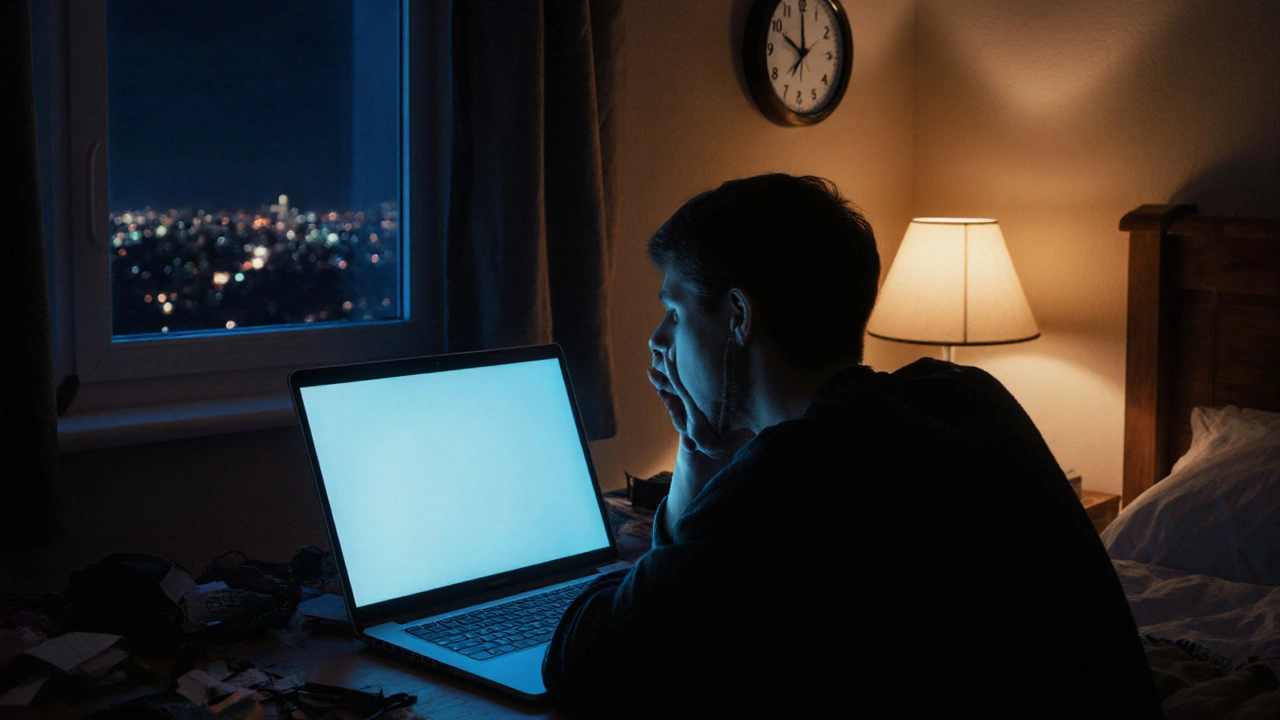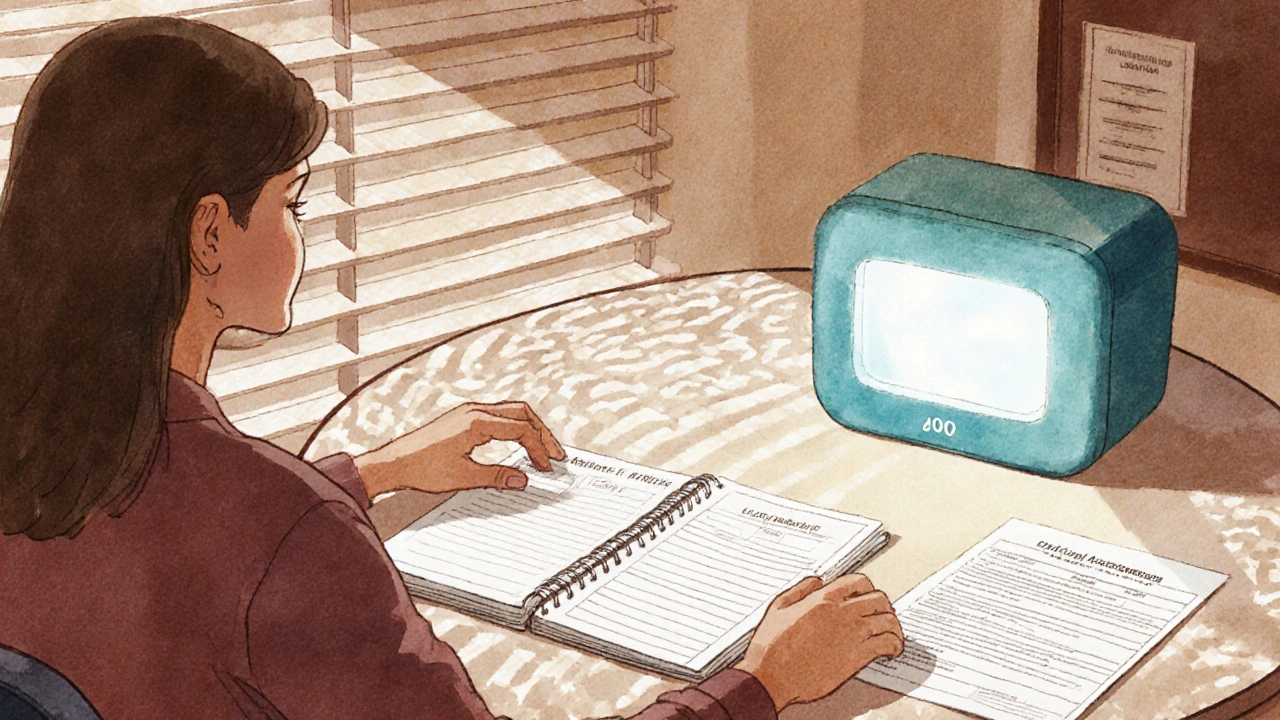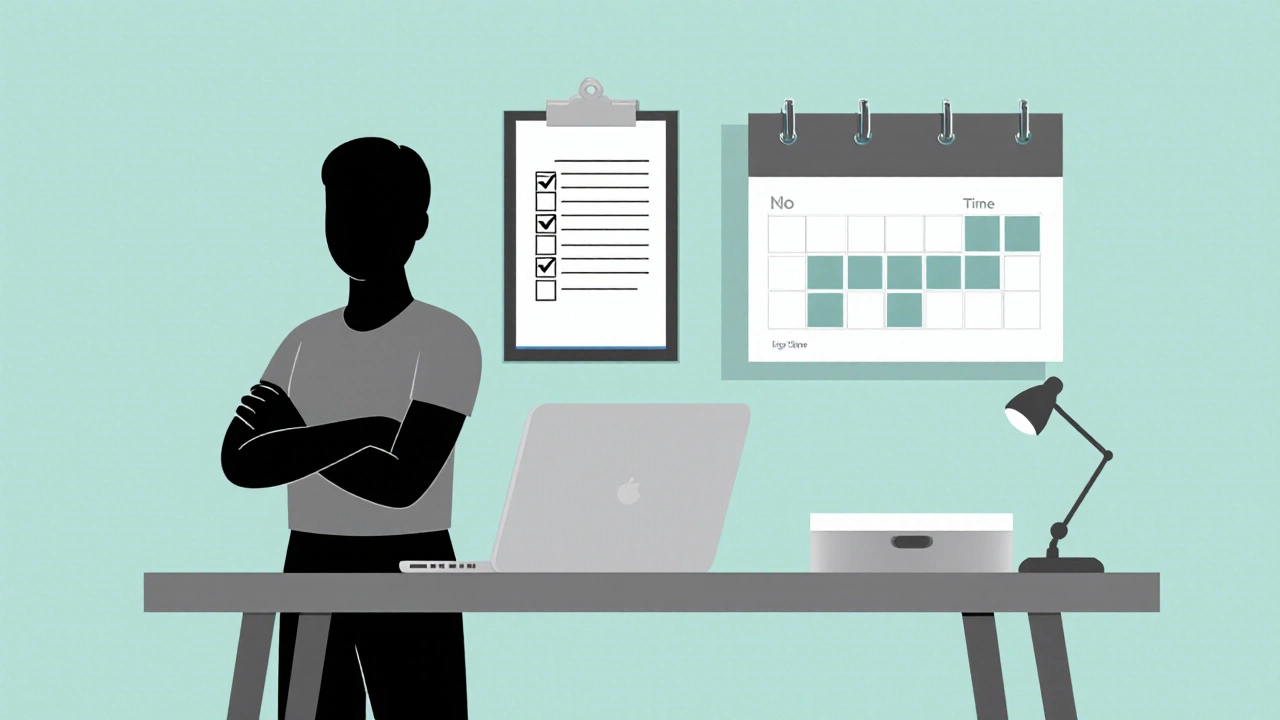How to Self‑Advocate for Delayed Sleep Phase Syndrome at School or Work

DSPS Sleep Schedule Calculator
Calculate Your Sleep Schedule
This tool helps you understand your natural sleep pattern and create evidence-based accommodation requests for school or work.
Your DSPS Sleep Pattern
RecommendedOriginal Sleep Window:
Adjustment Recommendation:
Accommodation Recommendation
Use this information when preparing your accommodation request letter. Include this schedule as evidence of how DSPS affects your daily functioning.
When you’re dealing with Delayed Sleep Phase Syndrome a circadian rhythm disorder that pushes your natural sleep window several hours later than the typical 10pm‑6am schedule, everyday expectations at school or the office can feel impossible. You might be the only student who consistently shows up late, or the employee who struggles to join early morning meetings despite getting enough sleep. Knowing your rights, the right language, and practical tools can turn a daily frustration into a manageable situation.
Key Takeaways
- DSPS is a recognized medical condition; you can request reasonable accommodations under ADA, Section504, or FMLA.
- Start with documentation: sleep diaries, actigraphy reports, or a clinician’s note.
- Tailor your request to the setting-schools favor IEP/504 plans, workplaces use accommodation letters or flexible schedule agreements.
- Use clear, solution‑focused language: propose specific changes like later start times, quiet workspaces, or light‑therapy breaks.
- Follow up with written confirmation and keep a record of all communications.
Understanding Delayed Sleep Phase Syndrome
DSPS is a type of circadian rhythm sleep‑wake disorder where the internal clock runs about two to six hours later than society’s norm. People with DSPS often feel most alert after midnight and have trouble falling asleep before 2am, even if they are exhausted. The condition affects roughly 0.2‑0.5% of the population and shows up in teens and young adults at the highest rates. While it’s not a "laziness" issue, the misalignment can cause chronic sleep deprivation, mood swings, and reduced academic or job performance.
Key biological players include melatonin release, light exposure, and the suprachiasmatic nucleus (SCN) in the brain, which acts as the master clock. Melatonin a hormone that signals the body it’s time to sleep typically peaks around 9‑10pm for most people, but in DSPS it may not rise until after midnight. Light-especially blue light from screens-can delay this peak even further.
Legal Foundations for Accommodation
In the U.S., two federal statutes form the backbone of accommodation rights:
- Americans with Disabilities Act (ADA): Treats DSPS as a disability if it substantially limits one or more major life activities, such as learning or working.
- Section504 of the Rehabilitation Act: Applies to public schools and colleges receiving federal funds, mandating equal access.
Many states also have their own disability‑rights laws that mirror or expand on these protections. For employees, the Family and Medical Leave Act (FMLA) can provide additional time off for treatment if DSPS requires ongoing therapy.

Step‑by‑Step: Gathering the Right Documentation
- Start a Sleep Diary: Log bedtime, wake time, caffeine intake, and daytime fatigue for at least two weeks. This creates a concrete picture of your pattern.
- Get a Clinical Evaluation: A sleep specialist can diagnose DSPS with tools like actigraphy (a wrist‑worn monitor) or polysomnography if needed. Request a written statement that includes the diagnosis, how it impacts your functioning, and suggested accommodations.
- Collect Supporting Research: Cite reputable sources such as the American Academy of Sleep Medicine or NIH fact sheets that acknowledge DSPS as a disorder.
- Prepare an Accommodation Request Letter: Summarize your diagnosis, impact, and specific adjustments you’re asking for. Keep a copy for your records.
Advocating at School: From IEP to 504 Plans
For K‑12 students and undergraduates, the most common routes are an Individualized Education Program (IEP) for those already receiving special education services, or a 504 Plan for broader accommodations.
| Accommodation | Purpose | Implementation Tips |
|---|---|---|
| Later start time | Align school hours with the student’s natural sleep window | Request a shift of 30‑60minutes; provide a physician letter. |
| Flexible attendance policy | Reduce penalties for occasional tardiness | Ask for documented exceptions rather than blanket leniency. |
| Quiet test environment | Minimize early‑morning cognitive load | Schedule exams in the afternoon when possible. |
| Recorded lectures | Allow review when missed morning classes | Coordinate with instructors for digital access. |
| Access to light‑therapy box | Phase‑advance circadian rhythm | Request school‑funded device or permission to use personal unit. |
When you meet with a school counselor or disability services officer, frame the conversation around how these adjustments help you meet learning objectives, not just about feeling better.
Advocating at Work: Flexible Schedules and Reasonable Adjustments
Employers are required to provide “reasonable accommodations” unless it causes undue hardship. Common workplace fixes include:
- Shifted start/end times: Moving the start time from 8am to 10am.
- Core‑hours work: Allowing you to work any hours as long as you’re present for a 4‑hour window that aligns with meetings.
- Remote work or hybrid schedule: Cutting the commute that often forces early waking.
- Designated quiet space: A low‑stimulus area for focused work when you’re most alert (typically late morning‑early afternoon).
- Light‑therapy breaks: Permission to use a light box for 30minutes in the morning to advance your rhythm.
Here’s a quick template you can adapt for an accommodation request email:
Subject: Request for Reasonable Accommodation - Delayed Sleep Phase Syndrome Dear [Supervisor/HR Manager], I have been diagnosed with Delayed Sleep Phase Syndrome, a medically recognized sleep‑wake disorder that shifts my natural sleep window several hours later than typical work hours. This condition impacts my ability to consistently arrive on time for early morning shifts, but does not affect my overall performance when I work during my peak alertness period (mid‑morning to early afternoon). To ensure I can meet all job responsibilities, I am requesting the following accommodation(s): 1. Adjusted start time to 10:00AM (or a flexible start between 9:00AM-11:00AM). 2. Option to work core hours from 12:00PM-4:00PM, with the ability to complete remaining tasks remotely if needed. 3. Permission to use a light‑therapy box for 30minutes each morning in a private area. I have attached a brief letter from my healthcare provider confirming the diagnosis and outlining why these adjustments are reasonable and effective. Thank you for your understanding and willingness to discuss this further. Sincerely, [Your Name]
After sending, follow up in writing after a week if you haven’t heard back. Keep a log of all communications-this can be crucial if a dispute arises.

Practical Lifestyle Strategies to Complement Accommodations
Even with accommodations, day‑to‑day habits can make a big difference. Consider these evidence‑based tips:
- Morning bright‑light exposure: Use a 10,000‑lux light box for 20‑30minutes upon waking to advance the circadian phase.
- Evening melatonin: A low dose (0.5mg) taken 4‑5hours before desired bedtime can help shift sleep earlier.
- Consistent sleep‑wake times: Even on weekends, stay within 30minutes of your weekday schedule to avoid a “social jetlag.”
- Screen curfew: Switch off phones/computers at least one hour before your target sleep time; use blue‑light filters if you must.
- Physical activity: Exercise in the late afternoon can promote deeper sleep without delaying melatonin onset.
These tools are not a substitute for legal accommodations, but they can reduce the severity of symptoms, making it easier to meet school or work expectations.
Common Pitfalls and How to Avoid Them
When you’re pushing for change, it’s easy to stumble into traps that stall progress:
- Vague Requests: Saying “I need help” without specifying the adjustment gives administrators room to deny.
- Skipping Documentation: Oral reports are rarely enough; always provide written medical evidence.
- Ignoring Chain‑of‑Command: Bypass HR or the disability office and you may violate policy, risking retaliation.
- Failing to Follow Up: After a meeting, send a recap email summarizing agreements; lack of paperwork can be used against you later.
- Assuming “One‑Size‑Fits‑All”: What works for a colleague with a different condition may not suit DSPS; tailor solutions to your rhythm.
Keeping a proactive, organized approach-documentation, clear language, and follow‑up-helps you stay ahead of these obstacles.
Next Steps: Building Your Personal Advocacy Plan
Start with a simple worksheet:
- Identify the Impact: List specific classes or tasks where lateness hurts performance.
- Choose Desired Accommodations: Pick two or three adjustments that directly address those impacts.
- Gather Evidence: Sleep diary, clinician note, research citations.
- Draft the Request: Use the email template above as a base.
- Schedule a Meeting: Contact the appropriate office (disability services, HR) and set a date.
- Follow‑Up: Email a summary within 24hours of the meeting, attaching all documents.
Remember, advocacy is a skill you can improve. Each successful adjustment strengthens your confidence for the next conversation.
Frequently Asked Questions
Is Delayed Sleep Phase Syndrome considered a disability?
Yes. Under the ADA and Section504, DSPS qualifies as a disability when it substantially limits major life activities such as learning, working, or caring for oneself. A medical diagnosis and documented functional impact are required to trigger accommodation rights.
Do I need a specialist’s note, or can a primary‑care doctor suffice?
A primary‑care physician can write a note, but a sleep specialist provides stronger credibility because they can confirm the diagnosis with tools like actigraphy. If a specialist isn’t accessible, ensure the primary doctor details the circadian misalignment and functional limitations.
Can I request a later start time without affecting my grades or performance reviews?
Yes, if you can demonstrate that the alternative schedule still allows you to meet learning outcomes or job goals. Provide a plan showing how assignments, labs, or project deadlines will be met within the adjusted hours.
What if my school or employer denies my request?
Ask for a written explanation of the denial. You can then appeal to the school’s grievance process or file a complaint with the EEOC (Equal Employment Opportunity Commission) for workplace issues. Consulting an attorney who specializes in disability law is advisable for serious pushback.
Are light‑therapy boxes safe for daily use?
When used as directed (10,000 lux, 20‑30 minutes each morning), light‑therapy boxes are generally safe. Avoid staring directly at the light; position it at eye level and keep a comfortable distance. People with bipolar disorder should consult a clinician first.

Lee Llewellyn
October 12, 2025 AT 04:20Obviously the whole "reasonable accommodation" spiel is just a bureaucratic hammock for the over‑sensitive, and I love how everybody pretends it’s a grand human‑rights crusade when, in reality, it’s a thinly veiled excuse for laziness. You think the United States is suddenly going to rewrite its corporate handbook because a handful of students can’t handle a 7 a.m. lecture? Ha! The free market already sorts out the weak from the strong, and any employer who bends over backward for a delayed sleep phase claim is practically signing a death warrant for productivity. Let me break this down: first, DSPS is a diagnosis that conveniently aligns with a millennial’s love for late‑night gaming; second, employers aren’t obligated to re‑engineer their entire schedule for a single individual; third, the legal language you cite (ADA, Section 504) is rarely invoked unless the applicant can prove a substantial limitation, which most DSPS sufferers cannot. You’d think a simple shift of an hour or two would be a non‑issue, but the ripple effects on team meetings, client calls, and project deadlines are obscene. Moreover, the “light‑therapy box” you recommend is just a glorified lamp that costs more than a decent pair of headphones, and you expect schools to fund it? That’s absurd. If a student truly cannot function without a 10 a.m. start, perhaps the solution is to find a career that doesn’t start at 9 a.m., not to force every professor to rearrange syllabi. The whole accommodation template you provide reads like a script from a Hollywood drama about the oppressed minority, when in fact the real oppression is the glorified victimhood mindset. So before you go flooding HR departments with your meticulously formatted request letters, consider whether you’re solving a problem or just adding paperwork to an already clogged system. In my view, the best advice is to adopt a disciplined sleep hygiene regimen, limit screen time, and stop blaming the system for personal chronotype choices. That, and perhaps learn to appreciate that the world runs on a schedule that isn’t designed for your personal convenience.
Drew Chislett
October 12, 2025 AT 04:30Great rundown! I think the key takeaway is that having solid documentation and a clear, solution‑focused request can really move the needle. It’s empowering to know that you can propose concrete adjustments like a later start time and still stay accountable for your work. Keep the tone professional and the goals specific, and you’ll increase the chances of a positive outcome. Remember, every step you take builds confidence for future advocacy.
Kristen Moss
October 12, 2025 AT 04:40Yo, just ask for a 10 am start and be done with it.
Rachael Tanner
October 12, 2025 AT 04:50While the template offers a solid foundation, it’s worth highlighting that the language should mirror the institution’s own policies. Aligning your phrasing with existing procedural language can smooth the review process. Also, citing peer‑reviewed articles reinforces credibility without sounding overly aggressive. A concise, well‑structured request often gets more traction than a verbose one.
Debra Laurence-Perras
October 12, 2025 AT 05:00I love how this guide brings together medical facts with practical steps in such a clear way. For anyone navigating the system, remembering to keep copies of every email and note is essential. The tone is encouraging, which can help reduce the anxiety that often accompanies these conversations. Let’s keep spreading this kind of supportive information!
dAISY foto
October 12, 2025 AT 05:10Wow, this is amazzzzing! – i totally feel the hype! You see, the whole thing is not just about paperwork, it’s about *your* life and dreams, ya know? So let’s crank that light‑box, sip that melatonin, and tell the boss we need that later start – no excuses! And yeah, don’t forget to write it all down, because the system loves paper. Let’s rock this DSPS journey together, fam!
Ian Howard
October 12, 2025 AT 05:20As a sleep‑medicine professional, I can confirm that the combination of a structured sleep diary and a brief note from a qualified provider is often enough to trigger accommodations under the ADA. It’s important to specify the functional impact – for example, reduced alertness during early‑morning meetings – rather than just listing the diagnosis. When drafting your request, include concrete suggestions such as a 10 a.m. start or a flexible‑hours window, and back them up with the evidence you collected. Also, remember to follow up in writing after any verbal discussion to create a paper trail. This systematic approach usually streamlines the approval process and reduces back‑and‑forth.
Chelsea Wilmer
October 12, 2025 AT 05:30One could argue that the very act of requesting accommodations is a manifestation of the modern individual’s quest for self‑actualization in a world that remains stubbornly indifferent to temporal variance. Yet, if we examine the epistemological roots of the ADA, we find an implicit acknowledgment that society bears a responsibility to accommodate divergent chronobiological patterns. Hence, the request is not merely a bureaucratic formality, but a philosophical dialogue between the self and the constructed temporal order. In this sense, the light‑therapy box becomes a symbolic beacon, illuminating the path toward a reconciled existence. However, the pragmatic reality remains: without concrete documentation-sleep diaries, actigraphy data-the abstract ideals dissolve into mere rhetoric. Therefore, the synthesis of empirical evidence and articulate advocacy creates a bridge from the subjective experience of delayed sleep to the objective mechanisms of institutional accommodation. By embracing both realms, one transcends the binary of compliance versus defiance, forging a nuanced stance that honors personal rhythm while navigating systemic constraints.
David Stout
October 12, 2025 AT 05:40Hey folks, just wanted to add that creating a supportive environment goes both ways. When you share your sleep diary with your manager, it shows you’re proactive, which can inspire teammates to be more open about their own challenges. A little empathy can turn a simple schedule tweak into a win‑win for the whole team. Keep the conversation positive and focused on solutions.
Pooja Arya
October 12, 2025 AT 05:50One must reflect on the moral imperative that underlies every request for accommodation. It is not merely a plea for convenience, but an assertion of one’s dignity against an unforgiving calendar. When we ignore the chronobiological suffering of our peers, we become complicit in a subtle tyranny of the clock. Let us therefore champion the cause of those whose internal rhythms are misaligned, lest we betray the very principles of fairness we claim to uphold. May our actions be guided by compassion, not by the cold calculus of productivity alone.
Sam Franza
October 12, 2025 AT 06:00Consider adding a brief note about your DSPS diagnosis and proposed start time to your HR portal.